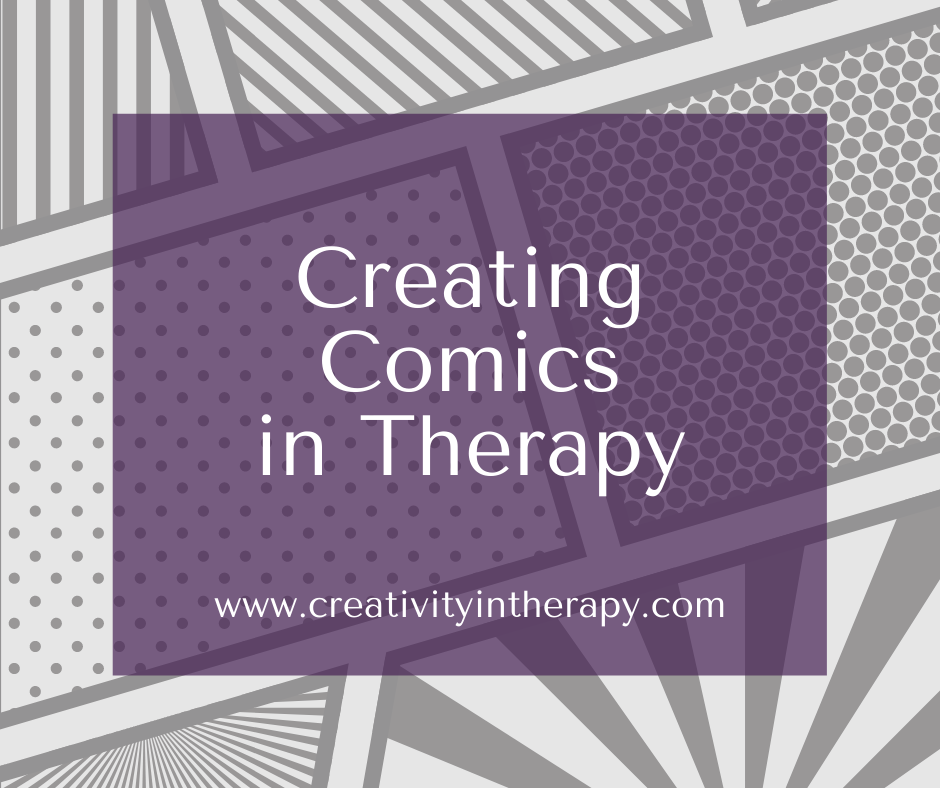
What comes to mind when you think of comics? While many people may think of funny comic strips or superheroes, comics are a broad art form that can be used to convey a variety of ideas and emotions. The stories told in a comic might be playful and fun or serious and meaningful, they may be rooted in real events or imagine a fantastical world, they may be brief glimpses told in a few panels or they can fill an entire graphic novel.
An important element of comics or visual narratives is that they often combine both images and words in order to tell a story, drawing on the power of both means of expression. This art approach can include a variety of similar, related art forms – comic strips, storyboards, visual narratives, graphic novels, multi-panel art, and sequential art. As with many art techniques, you can steer this activity in the direction that is best for your client. For some, that might mean using comics as a way for clients to tell a creative story in a fun way, working with the metaphors in the story. For others, it might be using multi-panel art to tell the story of a past experience or trauma.
Recently I was starting to feel a bit stuck in my telehealth art therapy approaches with some of my child clients, so we tried out some of the online comic strip and storyboard makers that are available. It turned out to be a great way to re-engage my clients, help them find a new way to be creative, and give them a way to share through storytelling.
While I mostly recently turned to comics in art therapy in order to encourage fun creativity, I have also used the sequential art format in the past to help children visualize new coping, plan for difficult situations, and creatively tell their TF-CBT trauma narrative.
Comic art can be done on paper or easily adapted to digital art. If you are doing telehealth right now, you can use one of the free online comic makers, send clients a PDF with pre-drawn panels, or have them draw their own panels on paper. When using a comic maker website with clients who are comfortable navigating online, I have had them share their screen with me so I could watch and discuss as they worked. For younger clients or anyone less comfortable with the websites, the therapist could create while sharing their screen and take verbal direction from the client.
Below are two (free) comic strip or storyboard platforms that I have tried and find work well.
Art Directives to Try Using Storyboards, Comics, and Multi-Panel Art
- Client-directed story: Let the client tell whatever story they want. As with other non-directive art or child-led play therapy, the therapist can observe, look for themes, support the client in the process, and help the client connect the process or content to broader meaning.
- Give a prompt to explore: Give the client a prompt and have them illustrate a story about it (e.g., What if you could have 3 wishes granted? How has Covid-19 affected your life? What do you think or hope school will be like this year? Tell me a story about someone who is brave.)
- Prepare and practice through the story: If you are working with a client on making a change or improving the way they handle a certain situation, have them practice and visualize how they will do that through creating a comic or storyboard together. Use the panels to show the event/trigger, the new steps the client will take, and what they expect the result to be.
- Create a visual coping skills reminder: Use the panels of the comic to show the client or another character engaging in the coping skills or positive activities that the client wants to remember to use.
- Tell a story together: As a relationship building activity, the therapist and client can work together in creating the story, taking turns adding elements and panels. In family therapy, you could have family members work together on this project.
- Process memories and tell your story: Art can be a powerful way to tell the story of a past trauma, difficult experience, or significant life event. Adding writing can help the client to further share and reauthor their story. The format of a storyboard or multi-panels can help the client to visually explore the whole narrative of what happened and even gives them the power to make changes. Remember that processing a narrative doesn’t only need to be negative or difficult events. You and your client may want to use the comic art to celebrate a success or positive event.
- Explore and dialogue with different parts of yourself: Create characters that represent different parts, exploring what they would say to each other or how each part wants to respond in a situation. (I found this great idea on the Graphic Medicine blog.)
Want to learn more? Here are a few articles and websites that I found really helpful.
Creating Comics with Clients – Counseling Today
Crisis Averted in Infinite Lives: Utilizing Comics as Clinical Art Therapy – Intima: A Journal of Narrative Medicine
Graphic Medicine website and blog
I’d love to hear your thoughts! Do you use comics or sequential art with your clients? And if you give it a try (either with client or for your own fun art-making), I’d love to hear how it goes.
Carolyn Mehlomakulu, LMFT-S, ATR-BC is an art therapist in Austin, Texas who works with children, teens, and families. For more information about telehealth and online therapy, individual therapy, child and teen counseling, and art therapy services, please visit: www.therapywithcarolyn.com. Carolyn is also the author of The Balanced Mind – A Mental Health Journal, a guided journal that combines writing and art prompts to support your mental health.
This blog is not intended to diagnose or treat any mental health conditions. All directives, interventions, and ideas should be used by qualified individuals within the appropriate bounds of their education, training, and scope of practice. Information presented in this blog does not replace professional training in child and family therapy, art therapy, or play therapy. Art therapy requires a trained art therapist.
* Posts may include affiliate links (see full disclosure here). If you’d like to help support the blog without any extra cost to you, please click through on links and shop as you normally would. Your support is greatly appreciated!





I have done sequential art many times with. Liners prior to Covid. Thank you for sharing this today. I am going to try it out on telehealth.